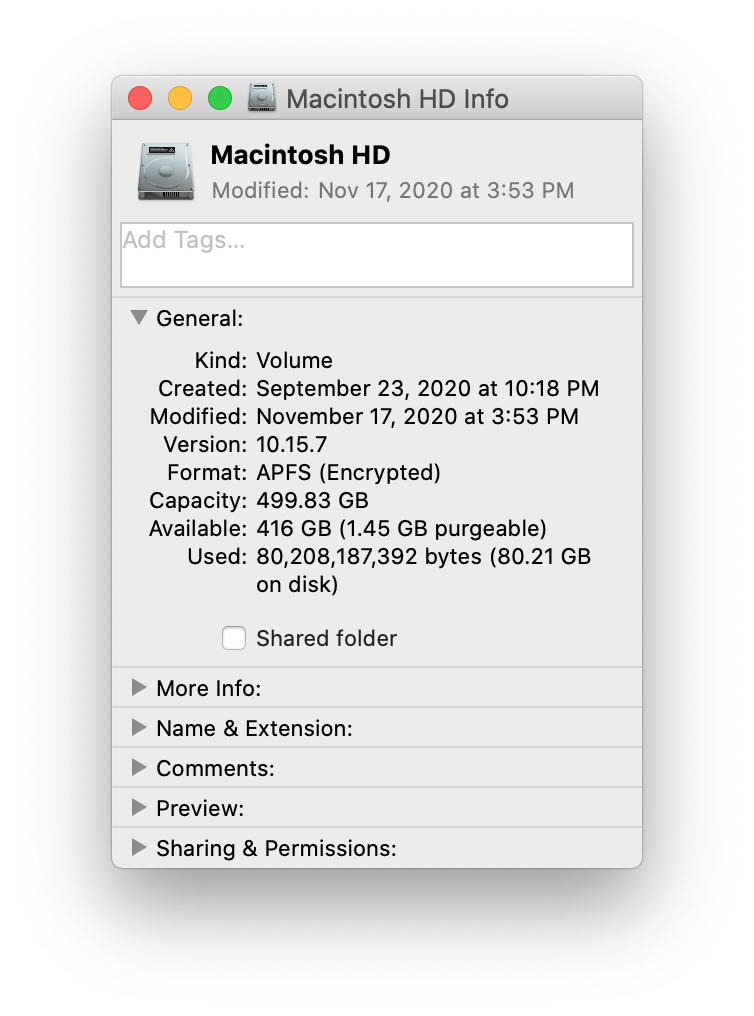Is your Mac’s hard drive getting full? Have you ever noticed that Apple designates some of your storage space as purgeable space? What is purgeable space? Apple introduced the concept of purgeable space in macOS 10.12 Sierra. If your Mac is using macOS Sierra or newer, you can easily see if it has so-called purgeable space. Click once on the Macintosh HD icon to select it. Click on the File menu, then select Get Info. Use the image below as a guide.
In the Get Info window, look at the line named Available. Prior to macOS Sierra this line only listed the truly available space. Now it lists both the truly free space as well  as purgeable space.
as purgeable space.
Purgeable space is storage space that is not free at the moment, but is nevertheless available to applications for use if needed. This sounds contradictory, I know. Purgeable space is storage space that has data stored in it, but may be reclaimed by macOS if your Mac is running low on storage space.
Both the Get Info window and the About This Mac window will show you both free space and purgeable space. The System Report window lists truly free space. To view the System Report, click on the Apple menu, select About This Mac. In the window that appears, click the System Report button. In the System Report window, click on Storage, which is about the 25th category listed on the left-hand side.
Purgeable space mostly consists of Time Machine local snapshots, caches, sleep images, swap files, and other temporary system files. Time Machine local snapshots are backup data which are stored on your Mac, separate from the backups on your Time Machine drive. When you reconnect your Time Machine backup hard drive these local snapshots are transferred from your Mac to your Time Machine backup drive. This is another reason why I recommend connecting your backup drive every day, to free up storage space on your Mac.
Furthermore, I’ve read that purgeable space can include the following:
- Movies and TV shows that you’ve bought from the iTunes Store and have already watched.
- Full-resolution version of photos stored in iCloud, if you use iCloud Photo Library
- Locally stored files that you keep in iCloud Drive, if you use iCloud Drive
- Large font files that are rarely or never used.
- Dictionaries that haven’t been accessed recently
As you can see, managing your storage space has gotten harder. It’s now more complicated.
When an application requests more storage space than is currently free, the system automatically and instantly reclaims the corresponding amount from the purgeable space.
When your Mac has ample free space, macOS allows the purgeable space to grow. I’ve seen purgeable space consume as much as 50% of the total storage space and I’ve read reports that it can claim as much as 80% of your Mac’s storage space.
Surprisingly, Apple lets Macs get about 95% full before they start to remove some of the purgeable files. I tend to recommend keeping more space available on one’s Mac. Thus, I send out notifications when one’s hard drive becomes 90% full.
You and I have little control over purgeable space. The best we can do is to:
- Connect our external Time Machine backup hard drives regularly to make sure local snapshots get transferred to the Time Machine drive. This way the local snapshots should not consume much, if any, storage space on your Mac.
- Manage the actual amount of data stored on our Macs. I tend to use and recommend DaisyDisk (currently $10) to inventory and clean-up hard drives. DaisyDisk provides an easy way to see some details about what’s designated as purgeable. It gives one an easy way to delete Time Machine local snapshots. DaisyDisk also lets one cull one’s personal accumulated data. Check it out.
But wait, there’s one more thing to keep in mind. To further complicate matters, the Mac operating system (macOS) calculates the amount of purgeable space asynchronously in the background. This means that there can be a delay of many minutes between when you delete files that consume purgeable space and the Get Info reflecting this change. If you wish to read more about purgeable space check out this information provided by DaisyDisk.
